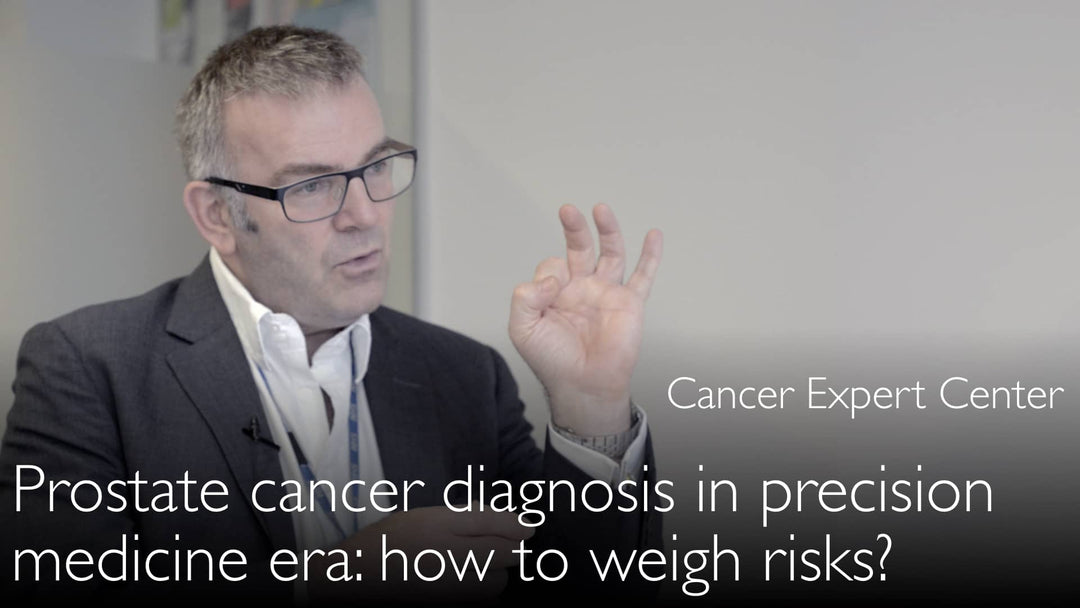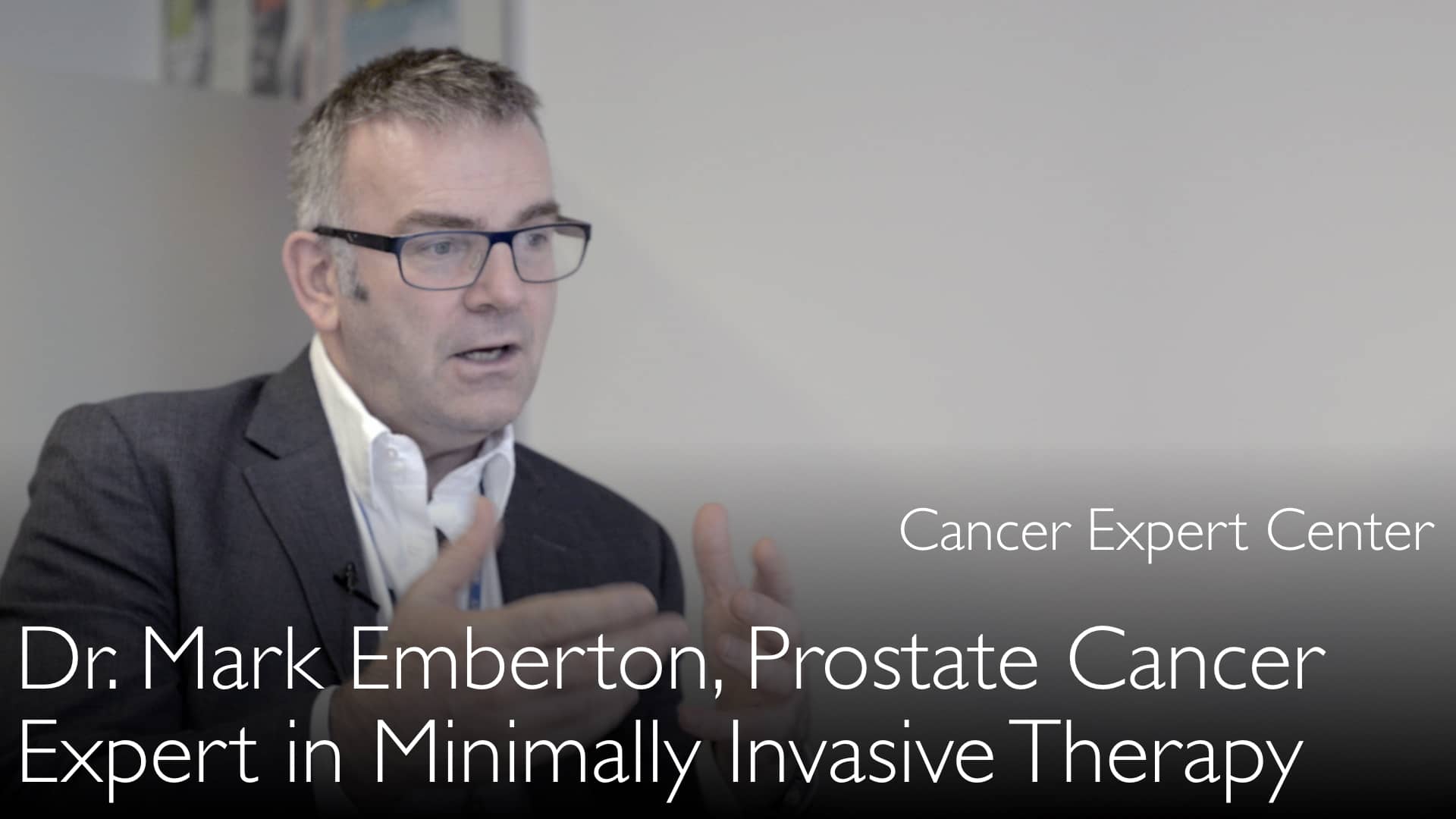מומחה מוביל באבחון וטיפול בסרטן הערמונית, ד"ר מארק אמברטון, MD, מסביר כיצד MRI רב-ממדי חולל מהפכה ברפואת הדיוק לגידולי ערמונית. הוא מפרט כיצד ביופסיות מונחות MRI מעניקות ודאות יוצאת דופן בדירוג הסרטן ובנפחו, ומאפשרות דיונים רציונליים יותר על מעקב פעיל או טיפול ממוקד. גישה זו מספקת יותר רקמה לבדיקות גנטיות ומולקולריות מתקדמות, ועוברת מעבר לטעויות ההיסטוריות של ביופסיות עיוורות לעידן חדש של אבחונים משולבי הדמיה מדויקים באורולוגיה.
אבחון מדויק של סרטן הערמונית: תפקיד ה-MRI והביופסיה הממוקדת
קפיצה לפרק
- MRI מחולל מהפכה באבחון סרטן הערמונית
- מאִי-ודאות ל-95% ודאות בדירוג הסרטן
- אפשור בדיקות סרטן מולקולריות וגנטיות
- טכניקת ביופסיה מונחית מיזוג MRI-אולטרסאונד
- השפעה קלינית על החלטות טיפול בסרטן הערמונית
- עתיד הטיפול בסרטן הערמונית בהנחיית הדמיה
MRI מחולל מהפכה באבחון סרטן הערמונית
אבחון סרטן הערמונית סוף סוף השווה לאבחון סרטן באיברים אחרים, הודות לשילוב הדמיה מתקדמת. ד"ר מארק אמברטון, MD, מאשר ש-MRI רב-פרמטרי של הערמונית הוא כיום אבן פינה בפרקטיקה אורולוגית מודרנית. התקדמות אבחונית זו מאפשרת גילוי סרטן ממוקד יותר ומשפרת משמעותית את ריבוד הסיכון, התקדמות קריטית בתחום שהיה מוכה historically באי-ודאות אבחונית.
הטכנולוגיה מספקת מה שהיה חסר במשך מאה שנה: מיקום מדויק של הסרטן בתוך בלוטת הערמונית. לפי ד"ר אמברטון, דיוק אנטומי זה משנה从根本上 את הגישה של אורולוגים לסרטן הערמונית, מעבר מניחושים לוודאות.
מאִי-ודאות ל-95% ודאות בדירוג הסרטן
Historically, אבחון סרטן הערמונית היה רצוף בטעויות פוטנציאליות כי רופאים nunca יכלו להיות בטוחים בהיקף המלא של הסרטן within הערמונית. ד"ר מארק אמברטון, MD, מסביר שהטיפול בוצע often "רק למקרה" שהיה נוכח סרטן אגרסיבי יותר. הפרדיגמה השתנתה now dramatically עם דיוק מונחה-MRI.
ד"ר מארק אמברטון, MD, מצהיר, "אנחנו יכולים now לומר, 'יש לי 95% ודאות שיש לך סרטן ערמונית בדרגה זו ובנפח זה'". דיוק יוצא דופן זה מגמה מהיכולת לזהות את גידול הקרצינומה, להכניס מחט directly לתוכו, ולהשיג דגימות רקמה truly מייצגות, מה שהופך ייעוצים עם מטופלים מהערכות לדיונים מבוססי ראיות.
אפשור בדיקות סרטן מולקולריות וגנטיות
הדיוק של ביופסיה מונחית-MRI לא רק משפר דיוק אנטומי—הוא פותח את הפוטנציאל לניתוח מולקולרי מתוחכם. ד"ר מארק אמברטון, MD, מדגיש שעל ידי השגת סנטימטרים של רקמת סרטן במקום מילימטרים, פתולוגים יכולים now לבצע בדיקות גנטיות מקיפות ולהעריך סמני סרטן מולקולריים חדשים.
שפע רקמה זה מאפשר להעביר דגימות ערמונית לבדיקות גנטיות, בדיקות התפשטות מולקולריות, וכל סמני הסרטן המולקולריים החדשים emerging currently. ד"ר אמברטון contrast זאת עם גישות historical שבהן ביופסיות עיוורות might להניב only מעט מאוד רקמה if הן פגעו בסרטן at all, מה שמגביל severely יכולות אבחון.
טכניקת ביופסיה מונחית מיזוג MRI-אולטרסאונד
While ביופסיה inside מגנט MRI אפשרית, ד"ר מארק אמברטון, MD, מסביר שאילוצים practical הופכים גישה זו challenging לרוב הסביבות הקליניות. סורקי MRI נמצאים במחסור globally ומציעים מרחב עבודה limited. Instead, רוב האורולוגים מאמצים טכניקות co-registration של תמונה לתמונה.
תהליך זה involves שימוש במדעי מחשב למיזוג מידע MRI עם הדמיית אולטרסאונד בזמן אמת. כפי שמתאר ד"ר אמברטון, "אנחנו then משתמשים במדעי מחשב כדי לרשום מחדש מידע MRI על האולטרסאונד." מיזוג זה מאפשר לרופאים לגשת לכל נתוני מיקום סרטן הערמונית במהלך פרוצדורה במרפאה באמצעות ציוד אולטרסאונד readily available, עם approximately 7-9 companies now המציעות פתרונות commercial לטכנולוגיה זו.
השפעה קלינית על החלטות טיפול בסרטן הערמונית
הדיוק שמספק אבחון סרטן הערמונית מונחה-MRI מתרגם directly לדיונים טיפוליים rational יותר. ד"ר מארק אמברטון, MD, מדגיש שעם ידע מדויק על דרגת הסרטן ונפחו, רופאים ומטופלים יכולים לנהל שיחות informed על whether לרדוף after טיפול active או ליישם פרוטוקולי ניטור careful.
ד"ר אנטון טיטוב, MD, מציין שגישה זו reflect את ההבנה הרחבה more that סרטן מייצג many מחלות שונות עם מאפיינים מולקולריים distinct. היכולת לאתר precisely ולדגום גידולי ערמונית enables תכנון טיפול המותאם לפרופיל הסרטן הספציפי של הפרט rather than יישום גישות one-size-fits-all המבוססות על מידע incomplete.
עתיד הטיפול בסרטן הערמונית בהנחיית הדמיה
שילוב MRI רב-פרמטרי באבחון סרטן הערמונית represent שינוי fundamental toward רפואה מדויקת. התובנות של ד"ר מארק אמברטון, MD reveal how טכנולוגיה זו העבירה את הטיפול בסרטן הערמונית מאִי-ודאות לביטחון, enabling דיוק אנטומי ומולקולרי both.
As טכניקות אלה become more widespread through פלטפורמות מיזוג תמונה commercial, מטופלים can לצפות לאבחונים accurate יותר, פרוצדורות unnecessary reduced, ותכניות טיפול המותאמות precisely למאפייני הסרטן הספציפיים שלהם. התקדמות זו finally מביאה את אבחון סרטן הערמונית in line עם התמחויות אונקולוגיות אחרות that נהנו long מהנחיית הדמיה precise.
תמליל מלא
ד"ר אנטון טיטוב, MD: MRI באבחון סרטן הערמונית: MRI ערמונית vs ביופסיה. MRI helps להימנע מביופסיה non-diagnostic and unnecessary. MRI רב-פרמטרי של הערמונית must להתבצע.
אז האבחון של סרטן הערמונית recently השווה לאבחון סרטן באיברים אחרים. ההתקדמות האבחונית has been made earlier באיברים אחרים. That allows אבחון ממוקד more וטיפול סרטן ממוקד more.
ד"ר מארק אמברטון, MD: נכון! וגם, יש לנו ריבוד סיכון better לסרטן הערמונית. זו מילה גדולה. But we used to לעשות many טעויות באבחון סרטן הערמונית. It meant that we were never really sure what cancer was in the הערמונית.
So when we found a little bit of cancer in the הערמונית, there was always possibility there could be more cancer. Therefore the treatment of סרטן הערמונית was done "just in case".
Now we can have extraordinary precision because we can identify the גידול קרצינומה של הערמונית. We can put the needle inside the tumor and get representative tissue. We can actually know exactly what's in the סרטן הערמונית.
And so instead of saying, "I think you have a low-risk cancer, Sir", we can now say, "I have a 95% certainty that you have a סרטן ערמונית of this grade and volume". So it's the רפואה מדויקת now that makes all the difference in אבחון סרטן.
If we were having a conversation about care, I would be able to say to you exactly what was in your הערמונית. We can have a rational discussion about how best to treat cancer. Whether to leave סרטן הערמונית alone, whether to watch it very carefully.
If we were going to treat cancer in the הערמונית, how we might approach the treatment.
ד"ר אנטון טיטוב, MD: So this reflect the trend that cancer is many different diseases of distinct molecular characteristics. Therefore, to say, "You have cancer of this organ", סרטן הערמונית, in this case, is not sufficient anymore. Cancer diagnosis has to be sophisticated and diagnosed at the molecular level and at precise anatomical level.
ד"ר מארק אמברטון, MD: נכון. So, the anatomy of בלוטת הערמונית we've talked about. We get really representative prostate tissue now during biopsy. We get also a lot of tissue.
This means that we can subject that tissue to genetic testing, to molecular proliferation testing. We can test all new molecular cancer markers that are coming out now. We can subject lots of רקמת בלוטת הערמונית to genetic cancer tests.
So historically, because you didn't know where the cancer was, we used to spread the biopsy needles. If there was a cancer there, you're lucky if you hit it once and you get a tiny bit of tissue.
Now we know where סרטן הערמונית is exactly. So you fire needles at it. So instead of giving one millimeter of cancer to the pathologist, we can now give a centimeter or two centimeters of cancer to pathologist. That allows us to undertake all these new genetic cancer tests.
ד"ר אנטון טיטוב, MD: You have already elaborated on that. But this is precisely the role for MRI in guiding ביופסיה של סרטן הערמונית.
ד"ר מארק אמברטון, MD: נכון. MRI gives us what has been missing for hundred years. It is a cancer location inside בלוטת הערמונית. Then we can use and exploit cancer location in two ways.
One method is to do the biopsy in the MRI magnet. Some people are doing that. But MRI is a very tight space. There's not a lot of space inside MRI to work in.
MRI time in most countries is in short supply. Most MRI scanners are full. So prostate biopsy inside MRI is quite challenging.
If you have an abundance of MRI scanners, which they do in some countries, particularly in Japan, and maybe in some cities within Europe, most of us are taking the information from MRI. We then use computer science to re-register MRI information on the ultrasound.
We could have an ultrasound in this room, one we're speaking in. You don't need any special equipment. But we certainly couldn't have an MRI scanner in this room.
And then you use the ultrasound scan and then merge the MRI information onto the ultrasound scan. This gives you all the information about סרטן הערמונית in real time in your office.
And so that's the way that most of us are going אבחון סרטן הערמונית. That's called image to image co-registration. There are about 7 or 8, maybe even 9 companies now offering commercial solutions for urologists and oncologists to get information location from one platform to another.
ד"ר אנטון טיטוב, MD: So this helps precise diagnosis. Therefore, it helps to identify a precise treatment plan for סרטן הערמונית for that patient.
ד"ר מארק אמברטון, MD: נכון!





